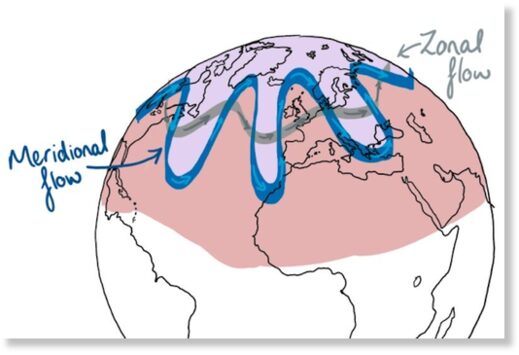The current Grand Solar Minimum is expected to last until about 2035, by which time the overall average temperature of the earth will likely have declined a few degrees. But wait, you say, Wasn’t it hot? In some spots, sure, but in others, it was cold, and the long-term averages will be lower (get into the weeds).
Related: NASA Says the Solar Minimum is Here. Climate Cult Says Meh, No Big Deal (But It Probably Is)
The Northern Hemisphere, in particular, will be a mix and mash of odd weather, common during a solar minimum, as we reported a few years back when it all started.
Solar minima are not wholesale drops in temperature as I understand it. The decrease in solar energy has a long term cooling effect but it’s not like turning off the heat. The seasons can get a bit odd. You will still have “weather,” meaning warm or hot spells, cool spells, especially in New England where the geography has taught us to wait a few minutes to see if the weather will change. And it does.
When I wrote that, it resulted from reading about the topic, but this past week, someone sent me some specifics on the science behind it. Higher levels of solar energy stabilize the jet stream. When that energy declines during solar minimums, the jet stream gets all wonky (or wavy), allowing warm air to move north and cold air to move south in weird and exotic ways. The result is areas in proximity with dramatically different weather.
The most immediately noticeable impact is the reduction of energy entering the jet streams, which changes the jet’s usual strong and straight ZONAL flow to a weak and wavy MERIDIONAL one.
Depending on which side of the stream you’re on, this means you’re either in for a spell of anomalously cold or warm weather and/or a period of unusually dry or wet conditions:
” …the perceived climatic changes can be fully explained by cyclical ‘buckling’ of the jet streams (Zonal to Meridional), itself caused by a bout of historically low solar activity.”
Here’s an actual real-world, current-day example of this in action (courtesy of the same link.)
Here it is, the omega blocking in all its glory, responsible for the annotated extreme weather events in Europe this week. pic.twitter.com/0TUmZMQzoT
— Mika Rantanen (@mikarantane) September 4, 2023
Related: NASA on the Solar Minimum – Next Cycle 30-50% Weaker than the Last
All of this is why, if you’d missed our previous prognostication, we think the left hit the accelerator on their Green Dream economic destruction plan. The science suggests that if they wait (which means they know the actual science), it will get too cool too often to keep the wool pulled over enough people’s eyes. It is now or never.
Selling the expected side effects of a solar minimum as extreme or chaotic just panders to their priorities at the expense of science and trillions of dollars in wealth redirected away from where it could do some good.
And yes, I suspect they understand the cost to economies, livelihoods, and lives. With fossil fuels verboten and affordable warmth at a premium, because wind and solar will always fail to deliver, people could (and will) freeze to death. That’s just alright with them. They must not have been the right sort of folks who could heat with oil or gas and virtue signal by purchasing carbon offsets. What is not alright is that there is still time to stop them. We can reverse the decline and ramp up oil and gas production in the US, and we must. There’s no way to build enough nuclear and hydro to meet the demands of their fossil-fuel-less future, not that the left would ever allow it.
But we need reliable, affordable energy for at least the next two decades while the sun takes a break; evidence of that need is all around us. What the left calls chaotic is normal, and your lifestyle has nothing to do with it.


